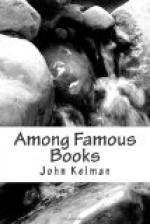There is no obvious sequence of the phases of the poem, nor any logical order connecting them into a unity of experience. They may or may not be a rescript of Thompson’s own inner life, but every detail might be placed in another order without the slightest loss to the meaning or the truth. The only guiding and unifying element is a purely artistic one—that of the Hound in full cry, and the unity of the poem is but that of a day’s hunting. One would like to know what remote origin it is to which we owe the figure. Thompson was a Greek scholar, and some such legend as that of Actaeon may well have been in his mind. But the chase of dogs was a common horror in the Middle Ages, and many of the mediaeval fiends are dog-faced. In those days, when conscience had as yet received none of our modern soporifics, and men believed in hell, many a guilty sinner knew well the baying of the hell-hounds, masterless and bloody-fanged, that chased the souls of even good men up to the very gates of heaven. Conscience and remorse ran wild, and the Hound of Hell was a characteristic part of the machinery that made the tragedy of life so terrific in those old days. But here, by a tour de force in which is summed up the entire transformation from ancient to modern thought, the hell-hounds are transformed into the Hound of Heaven. That something or some one is out after the souls of men, no man who has understood his inner life can question for a moment. But here the great doctrine is proclaimed, that the Huntsman of the soul is Love and not Hate, eternal Good and not Evil. No matter what cries may freeze the soul with horror in the night, what echoes of the deep-voiced dogs upon the trail of memory and of conscience, it is God and not the devil that is pursuing.
The poem, by a strange device of rhythm, keeps up the chase in the most vividly dramatic realism. The metre throughout is irregular, and the verses swing onward for the most part in long, sweeping lines. But five times, at intervals in the poem, the sweep is interrupted by a stanza of shorter lines, varied slightly but yet in essence the same—
“But
with unhurrying chase,
And unperturbed
pace,
Deliberate speed, majestic
instancy,
They beat—and
a Voice beat
More instant
than the Feet—
All things betray thee,
who betrayest Me.”
By this device of rhythm the footfall of the Hound is heard in all the pauses of the poem. In the short and staccato measures you hear the patter of the little feet padding after the soul from the unseen distance behind. It is a daring use of the onomatopoeic device in poetry, and it is effective to a wonder, binding the whole poem into the unity of a single chase.




